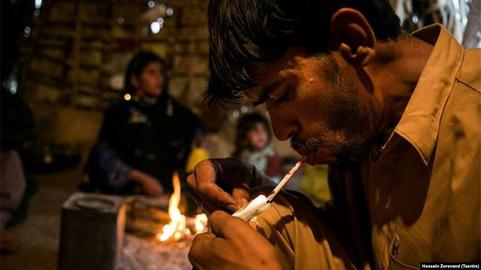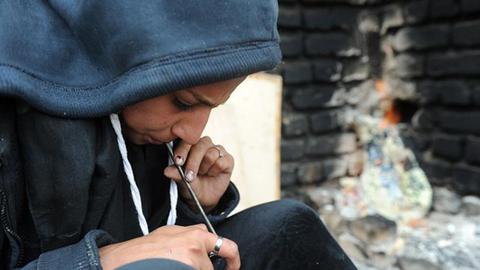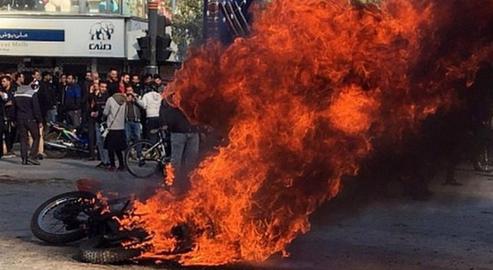The illicit drugs trade in Iran has shaped countless lives, exacerbated by punitive and misguided policies that have left some of society’s most vulnerable in the cold. In an exclusive new series for IranWire, academic Dariush Farahani lifts the lid on an under-reported contemporary crisis.
The aim of this series is to provide an insight into the drugs trade in Iran, including the impact of government policy on the drugs market, and to give a voice to marginalized communities affected by drugs that have been demonized in the media and public discourse.
Across the world and not least in Iran, drug users have been criminalized, stigmatized and treated as sick and malformed elements on the margins of society — a stance that strips them of their humanity and justifies harsh interventions into their lives. In recent years the so-called global “War on Drugs” has been questioned by an increasing number of actors. New human-centered and human rights-oriented policies and interventions are urgently needed to protect the rights of these individuals, and to prevent drug policy from further exacerbating violence, insecurity, and poor health outcomes in affected communities.
This series brings the global drug policy debate to Iran. We begin with an exploration of global drug policy before examining Iranian domestic drug policy in closer detail. Follow-up articles take in the breadth of drug users’ lived experiences in Iran and the haphazard management by government and civil society actors, based on interviews with people in Iran affected by drugs, be it as a user of opium, heroin or methamphetamine (shisheh), or by their involvement in the production, trafficking or distribution of illegal substances.
International Drug Control: Goals and Shortcomings
Psychoactive drugs have captivated scholars, policymakers, and the public for centuries if not millennia. These substances have been consumed to treat a range of ailments and to experience euphoria and pleasure, as well as being deployed in cultural and religious rituals. Their use has been depicted by poets and artists alike.
In modern times, a prohibitionist stance has informed the regulation of illicit drugs. Vast resources have been ploughed into the criminalisation of production, trafficking, distribution and consumption of drugs to achieve the overarching goal of a reduced global supply and demand of narcotics.
However, after more than a century of international drug control, the failures of the prohibitionist approach are starkly apparent. In 2008 the United Nations Office on Drugs and Crime (UNODC) published a report outlining the “unintended consequences” of drug control: an important milestone in which the UNODC recognised the long-suspected shortcomings of the global drug control system, and by extension, of the so-called “War on Drugs”.
One of the key unintended consequences outlined in the UNODC report was that prohibition has created and exacerbated a lucrative global illicit market for drugs controlled by criminal organisations: not dissimilar to the black market that emerged after alcohol was prohibited in the US from 1920 to 1933.
Estimated revenues generated by the unlawful production, trafficking and distribution of drugs vary wildly. A 2017 report by US think-tank Global Financial Integrity estimated the annual value of global drug trafficking to be between $426 billion and $652 billion: second only to counterfeiting among the world’s most lucrative illicit trades.
Experts and scholars have fiercely criticised repressive government policies on drugs for years. The past decades, they argue, have shown that drugs are becoming cheaper and more widely available than ever before. More devastating than the global drug control system’s failure to achieve its goals has been the detrimental impact prohibition has had on the human rights, health, and well-being of vulnerable drug-affected communities. Prohibition has led to increased violence in drug markets, exacerbated conflicts and insecurity, and undermined the achievement of the UN’s Millennium Development Goals and Sustainable Development Goals. In recognition of the failures, more and more states from Canada to Uruguay are now experimenting with new forms of regulating formerly illegal drugs.
Drug Policy in Iran: From the Safavids to Modern Harm Reduction
Iran has had a long relationship with psychoactive drugs, particularly opium. As in many other countries, opium has been used as an incredibly effective pain relief medication in Iran for centuries. From the Safavid dynasty onwards, drug policy in Iran was dictated by the Shah and oscillated pendulum-like between approval and prohibition..
In more modern times Iran has experimented with several models of drug regulation, including as the system of regulated opium supply known as Sahmiyah that was in operation until the 1979 Islamic Revolution.
After the Constitutional Revolution in the early 1900s the Iranian government instituted its first official law on drugs, limiting cultivation and restraining opium use in public – and alongside other measures, giving opium users seven years to quit their habit. In the decades that followed, the government struggled to contain opium cultivation and consumption as it became an important stream of government revenue. From the early through to the mid-20th century, taxation of the opium trade became an integral part of the national economy, accounting for up to 9 percent of GDP. As time passed the government of Mohammad Reza Shah Pahlavi experimented with various regulatory models such as the opium voucher system, whereby certain groups such as the elderly could buy a set amount of government-proscribed opium each month.
The 1979 Islamic Revolution would signify a radical break from the policies of the past. Although severe sentences had been handed down to illegal drug suppliers during the Shah’s reign, when Sadegh Khalkhali infamously took charge of the post-revolutionary anti-narcotics campaign in May 1980 hundreds of executions of drug offenders, including drug users, took place alongside those of political dissidents and others declared “morally decrepit”.
Unsurprisingly, the ‘drug problem’ was not resolved. Instead, in the aftermath of the Iran-Iraq war, a traumatised community of veterans, their families and the general public turned to drugs to ease their pains and provide relief from the horrors of war. During the 1990s, a combination of the rapid spread of HIV – particularly in prisons – and the rise of reformist politics prompted a change in Iranian drug policy as so-called “harm reduction” measures were rolled out for drug users. Iranian intellectuals and medical practitioners were at the vanguard of the spread of harm reduction as an alternative to punitive sanctions and incarcerations.
Since then, unfortunately, the harm reduction movement in Iran has been undermined. The end of the reformist era, the rise of a new conservativism that crystallised in the government of Mahmoud Ahmadinejad, and recent escalations in regional tensions have seen humane and health-centred drug policies de-prioritised.
Drug Flows in Iran: Trafficking and Use
Iran lies on the Balkan and Southern Routes: two globally-recognised “superhighways” for Afghan-produced opium trafficking. The Balkan Route has long been the largest single heroin and opium trafficking pathway in the world. Around 82 percent of global opium production and the vast majority of global heroin production takes place in Afghanistan. Production rapidly increased after the Islamic Revolution and the ensuing eradication of poppy cultivation in Iran, coinciding with drastic reductions in Turkey and Pakistan.
Decades of turmoil in Afghanistan have rendered the drugs economy a vital backbone for rural and struggling communities across the country. The farm-gate value of opium alone accounted for an estimated 7 percent of Afghanistan’s GDP in 2017, before any other stages of the supply chain.
Because of its proximity to Afghanistan, vast quantities of illicit drugs flow into Iran via its eastern borders. According to the UNODC’s annual World Drug Report, 20 percent of global heroin and morphine seizures in 2017 took place in Iran, as well as 91 per cent of all opium seizures. In total, Iranian authorities confiscated 669 metric tonnes of opiates in 2017: more than nine times that of their counterparts in Afghanistan and Pakistan.

The overspill from these drugs passing through the Balkan and Southern Routes across Iran is enormous. Iran is consistently recognised as the country with the second-highest level of opiate dependence in the world. Official estimates of the number of “drug addicts” in the country in 2014 ranged from 1.2 million to 3.7 million adults, with the Iranian Drug Control Headquarters claiming the figure had reached 2.8 million by 2017. Substance abuse has become a widespread issue in contemporary Iran as the population grapples with unprecedented economic pressure and internal political crisis. Despair and hopelessness have driven many people to find solace through the consumption of drugs.
The Future of Iranian Drug Policy
An array of treatment interventions and harm reduction measures are still available for drug users in Iran – if dependant on their location. The Iranian drug treatment system has rightfully been regarded as foremost in the region and perhaps globally, particularly in the provision of methadone, buprenorphine, and opium tincture to drug users.
The treatment system, however, is fraught with corruption and regularly attracts complaints about alleged violations of drug users’ rights, particularly in the so-called drug treatment camps that have expanded rapidly over the past decade. To be deemed a regional or indeed global leader in drug treatment is hardly a major accolade considering the repressive policies and poor resourcing of many other states.
In late 2017, following international condemnation, the Iranian government opted to review the sentences of those facing execution for drug offences and simultaneously raised the bar for capital punishment for drug crimes. Prior to this, Iran had ranked second after China in annual drug-related executions. In fact, the majority of executions in Iran since the Islamic Revolution have been for drug-related offences: in her 2011 study Drugs, Deviancy and Democracy in Iran, the Danish sociologist Janne Bjerre-Christensen noted that more than 10,000 drug offenders have been executed in Iran since 1979.
The 2017 policy change spared the lives of more than 5,000 individuals incarcerated for drug-related offences. But the Iranian state still reserves the right to execute people caught in possession of certain quantities of drugs, as well as those who may have carried firearms in the course of the offence, members of organised crime groups, and those thought to be exploiting minors or mentally ill persons. At the same time, the trauma and injustice suffered by family members of those who had their sentences commuted has not dissipated but entered a new stage.
The amendment has also not been a decisive enough step in a more compassionate direction. Many questions on the future of Iranian drug policy remain unanswered. As the country faces a new stage in its internal political and economic crisis, the “drugs issue” has been relegated down the priority list, with NGOs and treatment providers working on behalf of drug-affected communities reporting a desperate lack of funding.
The decline of harm reduction and the rise of new, non-evidence-based forms of treatment, such as internment in camps, in combination with increasing desperation and poverty among the Iranian people, is likely to lead to an increase in drug use. At the same time, as Christensen observes: “Whenever the regime faces escalating crises, internally or externally, the public hangings of drug users increase.”
While some have argued that the Iranian government is slowly moving towards more progressive drug policies, and even potentially a regulated market for opium and cannabis, others remain sceptical.
This series aims to bring a human, on-the-ground perspective to these issues by exploring the lives and fates of those involved with drugs, their families and communities, and the NGOs and treatment providers fighting for their rights.
Read the series:
Selling Heroin After the Revolution
The "Moratorium" on the Death Penalty
Hopelessness, Drug Use and “Parti Bazi”
A Meeting With Narcotics Anonymous
Inside the Government-Sponsored “Treatment Camps”
visit the accountability section
In this section of Iran Wire, you can contact the officials and launch your campaign for various problems



























comments